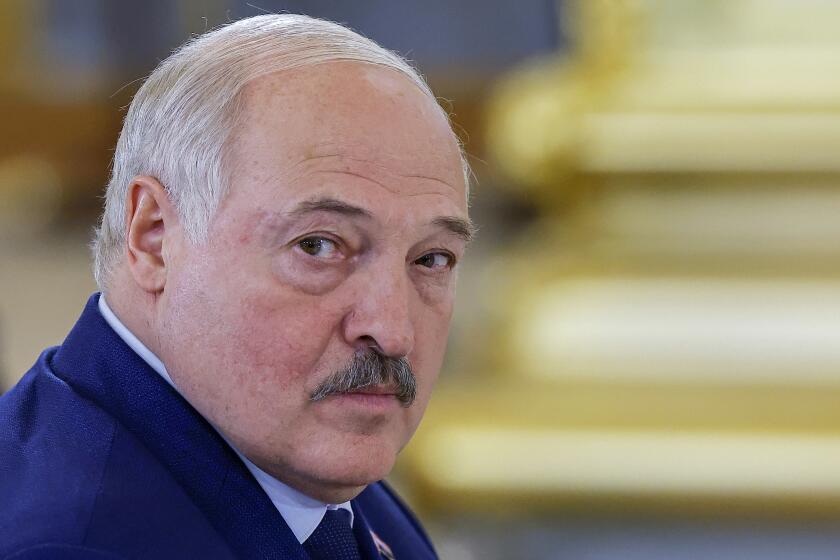Once-Splendid Medieval Cairo Crumbles Into Ruins
Sewer water creeps several yards up the limestone walls of the 700-year-old Islamic school, eroding the precious inscriptions adorning one of Cairo’s architectural jewels.
Fissures as deep as 2 inches scar the walls. Flakes fall from the stone blocks when they are merely tapped with a pen.
The remnants of medieval Cairo, once the seat of an empire stretching from Sudan to Syria, are crumbling, victims of a leaky sewer system, rumbling traffic and choking pollution.
“In 20 years’ time there will not be a single minaret standing,” warns Costante Muzio of the United Nations Development Program.
The United Nations is preparing a rescue plan for critical areas of the city. The Egyptian government, along with teams from the United States and Germany, is working to save specific treasures. But even those involved in the efforts admit the task is overwhelming.
Medhat Menabbawy, the official in charge of antiquities in northern Cairo, has a short answer when asked if all 200 monuments in his area can be saved: “Impossible!”
He said the government has set aside $9 million to restore mosques, schools and tombs in his district, once a center of the medieval city. That covers only 13 monuments in the northern area, which holds one-third of Cairo’s Islamic architectural treasures.
For the most part, the government has focused on preserving the treasures of Egypt’s Pharaonic era--which draw thousands of tourists daily--while the remnants of what was once a great medieval city turn to dust.
More than 600 years ago, the famous Arab traveler Ibn Battuta described Cairo as the “mother of cities . . . boundless in the multitude of buildings, peerless in beauty and splendor.”
That endowment must be preserved, Menabbawy said. “It is not only our heritage. It is the world’s heritage.”
The dangers confronting medieval buildings are largely the problems plaguing the rest of the overcrowded metropolis of 16 million people.
The exploding population has overwhelmed Cairo’s antiquated sewer system, which leaks contaminated water that is sucked up by the mortar between the limestone bricks that form the foundations of many medieval buildings.
Trucks and buses rumbling through the city cause vibrations that damage the monuments. Pollution from factories and cars leaves a layer of grime on almost everything, eroding the delicate inscriptions on many of the monuments.
“The damage has accelerated enormously in just the past three or four years,” says John Rodenbeck, head of the Society for the Preservation of the Architectural Resources of Egypt.
In the heart of what is left of one of the most intact medieval cities in the world, hostels, mosques, Islamic schools and bathhouses are dissolving.
The damage is apparent at one of the most important medieval treasures, a complex built by Sultan Qalawun, who rose from slavery to found a dynasty that ruled Egypt for a hundred years in the 13th and 14th centuries.
Some of the arched vaults at the Qalawun school have cracks a yard long. In the sultan’s tomb, the brown, red and white geometric mosaics on some of the walls are buckling so badly they make a hollow sound when tapped. A few are covered with white gauze to prevent pieces from falling.
At the Sultan al-Nasir Mohammed school, built by Qalawun’s son, gray grime covers the Gothic portal that medieval Muslim warriors brought from a Crusader church and later used as the entrance to the school.
The Qalawun complex, at least, is being rescued. Menabbawy said a project costing $5.5 million began in July and should be completed in 2 1/2 years.
The United Nations says a broader, coordinated effort is needed to save much more of the Islamic city, which Muzio estimates would cost tens of millions of dollars.
“We are talking of fixing an area of the city that includes 2 million people,” he says.
U.N. officials are expected to present a rescue plan for Islamic Cairo to Egypt by year’s end. Even if it is approved, the United Nations would then have to appeal for funds from international donors, many of whom face their own tight budgets.
More to Read
Start your day right
Sign up for Essential California for news, features and recommendations from the L.A. Times and beyond in your inbox six days a week.
You may occasionally receive promotional content from the Los Angeles Times.






